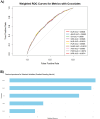Exploring immune-inflammation markers in psoriasis prediction using advanced machine learning algorithms
- PMID: 40821804
- PMCID: PMC12350470
- DOI: 10.3389/fimmu.2025.1619490
Exploring immune-inflammation markers in psoriasis prediction using advanced machine learning algorithms
Abstract
Background: Psoriasis is a chronic immune-mediated inflammatory skin disorder characterized by multifactorial pathogenesis. Recent studies have extensively highlighted the strong associations between psoriasis and various inflammatory markers, which are considered novel predictive tools for evaluating systemic inflammation.
Methods: Cross-sectional data from the NHANES were analyzed in this study. To assess model performance and generalizability, the dataset was randomly divided into 70% for training and 30% for validation. To address class imbalance in the training data, a hybrid resampling technique (SMOTEENN) was applied. Subsequently, nine classification algorithms were developed using the processed training set, including random forest, neural networks, XGBoost, k-nearest neighbors, gradient boosting, logistic regression, naïve Bayes, AdaBoost, and SVMs. The final gradient boosting was implemented via the gbm package in R, with hyperparameters selected from the default tuning grid of the caret framework. Inflammatory biomarkers with the highest classification utility were identified based on the predictions of the best-performing model.
Results: A total of 22,908 participants were included in the final analysis. Gradient boosting (AUC: 0.629, 95% CI: 0.588-0.669) demonstrated the highest performance, followed closely by logistic regression (AUC: 0.627, 95% CI: 0.588-0.666). Among all the inflammatory markers, MLR exhibited the best classification performance, with an AUC value of 0.662 (95% CI: 0.640-0.683), followed by NLMR, with an AUC value of 0.661 (95% CI: 0.640-0.683). Other markers, including the NLR, dNLR, SII, SIRI, and PLR, had AUC values ranging from 0.658 to 0.661. The MLR had the highest relative importance score, demonstrating its critical role in the model's predictive performance for psoriasis classification. The NLR ranked second, followed by the SII and SIRI, which had moderate contributions, whereas the PLR contributed the least.
Conclusions: Among all the tested algorithms, the gradient boosting model achieved the best performance. Not only does it achieve the highest predictive accuracy, but it also excels in classification efficacy and feature importance analysis, highlighting key inflammatory markers such as the MLR, SII, and NLR. These markers are significant as reliable indicators for evaluating systemic inflammation and predicting the development of psoriasis, emphasizing their potential clinical applications.
Keywords: machine learning algorithms; monocyte-to-lymphocyte ratio; national health and nutrition examination survey; neutrophil-to-monocyte ratio; psoriasis.
Copyright © 2025 Yang, He, Tang, Qin and Zheng.
Conflict of interest statement
The authors declare that the research was conducted in the absence of any commercial or financial relationships that could be construed as a potential conflict of interest.
Figures





Similar articles
-
Comparison of Two Modern Survival Prediction Tools, SORG-MLA and METSSS, in Patients With Symptomatic Long-bone Metastases Who Underwent Local Treatment With Surgery Followed by Radiotherapy and With Radiotherapy Alone.Clin Orthop Relat Res. 2024 Dec 1;482(12):2193-2208. doi: 10.1097/CORR.0000000000003185. Epub 2024 Jul 23. Clin Orthop Relat Res. 2024. PMID: 39051924
-
Predictive value of systemic inflammatory indices for perinatal outcomes following cervical cerclage: a retrospective cohort study.BMC Pregnancy Childbirth. 2025 Jul 10;25(1):750. doi: 10.1186/s12884-025-07888-3. BMC Pregnancy Childbirth. 2025. PMID: 40640782 Free PMC article.
-
Supervised Machine Learning Models for Predicting Sepsis-Associated Liver Injury in Patients With Sepsis: Development and Validation Study Based on a Multicenter Cohort Study.J Med Internet Res. 2025 May 26;27:e66733. doi: 10.2196/66733. J Med Internet Res. 2025. PMID: 40418571 Free PMC article.
-
Systemic pharmacological treatments for chronic plaque psoriasis: a network meta-analysis.Cochrane Database Syst Rev. 2017 Dec 22;12(12):CD011535. doi: 10.1002/14651858.CD011535.pub2. Cochrane Database Syst Rev. 2017. Update in: Cochrane Database Syst Rev. 2020 Jan 9;1:CD011535. doi: 10.1002/14651858.CD011535.pub3. PMID: 29271481 Free PMC article. Updated.
-
Systemic pharmacological treatments for chronic plaque psoriasis: a network meta-analysis.Cochrane Database Syst Rev. 2021 Apr 19;4(4):CD011535. doi: 10.1002/14651858.CD011535.pub4. Cochrane Database Syst Rev. 2021. Update in: Cochrane Database Syst Rev. 2022 May 23;5:CD011535. doi: 10.1002/14651858.CD011535.pub5. PMID: 33871055 Free PMC article. Updated.
References
LinkOut - more resources
Full Text Sources

